Top 6 Enterprise IT Trends to Watch in 2018
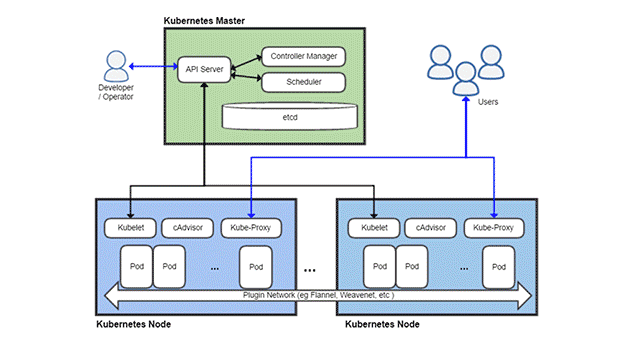
Early in 2017, we published a series of posts about the ongoing, top 10 trends in enterprise IT. We examined several issues independently and summarized them in the context of global innovation. Here, we investigate whether these topics stayed the same and what else to expect in the era of digital transformation. This time out, we summarized today’s technology trends into six areas.
Trend #6: Cloud-native spreads throughout F500
Last year, we discussed the revival of PaaS. This year, we will observe how PaaS serves as a foundation for cloud-native development and related practices, such as microservices or CI/CD. Large enterprises seem to give this view some credibility, as it was reported in 2017 that 50% of Fortune 500 companies are now using the Cloud Foundry platform.
Let’s examine a few good examples of the success with cloud-native platforms—in particular, with Cloud Foundry:
- KONE was able to add smart monitoring to 1.1 million elevators worldwide. With the use of IBM Bluemix and Watson, the company and its customers can now use predictive analytics to obviate maintenance emergencies but also to improve the flow of people across the world.
- Speaking of millions of things, the engineering company Bosch connected six million devices in its IoT Cloud in no small part to Cloud Foundry’s ability to work in a multi-cloud, multi-vendor environment.
- Honda also employed IBM Bluemix and Watson to push forward its connected-car initiative, with the goals of not only improving traffic flow but more important, safety. The use of a “cognitive assistant” can coach drivers of all ages and experience through a variety of situations.
- Thinking about cars makes for a natural segue to insurance companies, and we reported on a couple of them and their use of Cloud Foundry. CSAA Insurance Group, which provides insurance to the American Automobile Association (AAA), focused on continuous integration to increase its deployments to three times per day.
- Meanwhile, Liberty Mutual developed a transformative program that cut through sluggish legacy processes to create a new culture of continuous integration and develop apps in significantly shortened timeframes.
We have covered these and 30+ other Cloud Foundry stories, spanning across several industries and countries.
Going hand-in-hand with this trend is the use of containers and microservices as an essential piece of cloud-native development. Containers and microservices are also neatly tied with the idea of continuous integration / deployment (CI/CD), which is in turn a cornerstone of building apps and services quickly and imbuing your organization with the agility to continue to deliver what’s needed.
Looking at the bigger picture, we can see that after many years of promotion and adoption, cloud computing still only garners maybe 10% of all enterprise workloads. Perhaps a more important point is that it is expected by one estimate to command 60% of IT growth for at least the next few years. Despite this, cloud has still not quite taken over the world.
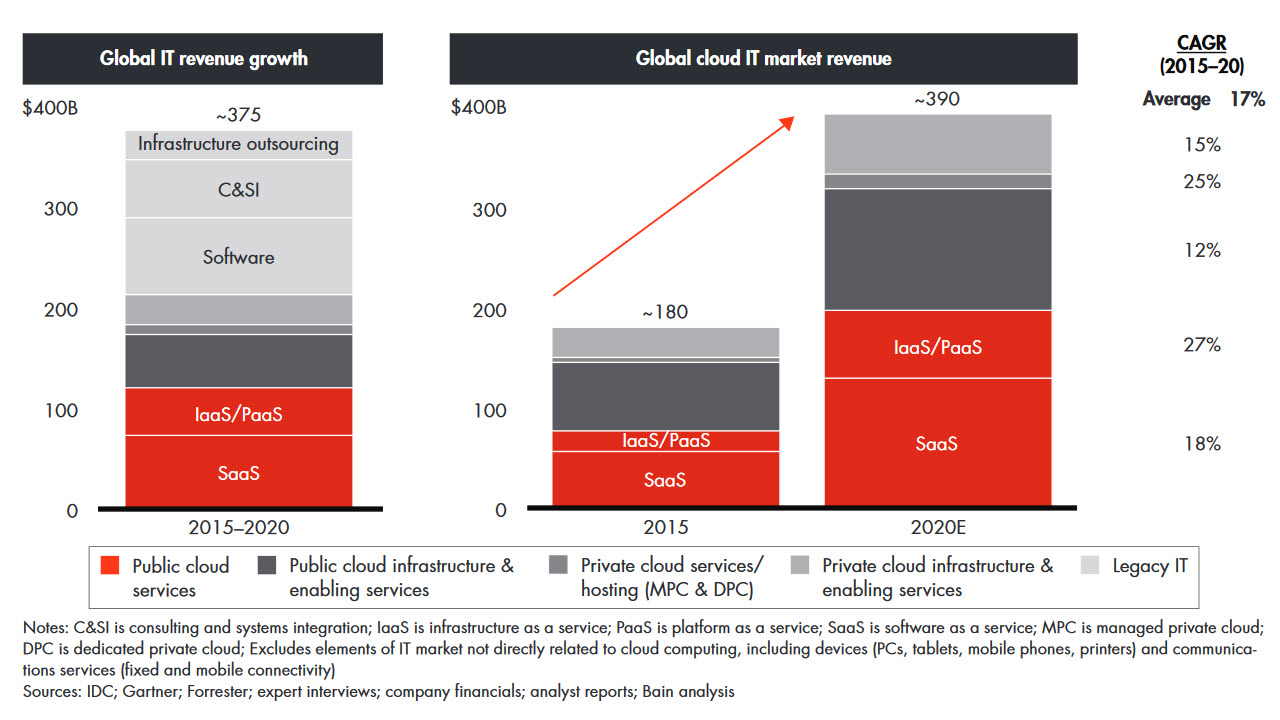 Cloud made up 70% of IT growth from 2012–2015 (Source)
Cloud made up 70% of IT growth from 2012–2015 (Source)Yet there remains some confusion and chaos regarding particular platform and cloud-native technologies and how they can be used. A good example of this is provided by well-known analyst Ben Kepes tackled this issue recently with a nod to our friends at the Cloud Foundry Foundation. Ben conceptualized a grand bargain among the Foundation, the OpenStack community, and the Cloud-Native Computing Foundation.
He opened with the ideal scenario where enterprises could rely on a single open-source stack for their needs instead of turning to multiple difference organizations. He provided a nice history lesson of why this would remain a pipedream, but didn’t dive too deeply into the topic technically, citing “politics.” Ben also made the point, or at least implied, that enterprise IT managers don’t buy religion, they buy very specific technologies for very specific needs.
Trend #5: The rise of Kubernetes
The amazing rise of Kubernetes adds another layer to the discussion, it was the unexpected superstar of the year. This development shook the Cloud Foundry community to the core, garnered attention well beyond the tech blogosphere, and demonstrated the phenomenal power of Google and much that it creates. Kubernetes now casts a shadow over everything else in the world of cloud deployment, and I can make the fearless, risk-free prediction that it will continue to do so in 2018.
Kubernetes also played a role in shifting the focus of enterprise IT discussions from specific platform debates to an overall discussion of cloud-native platforms and deployments.
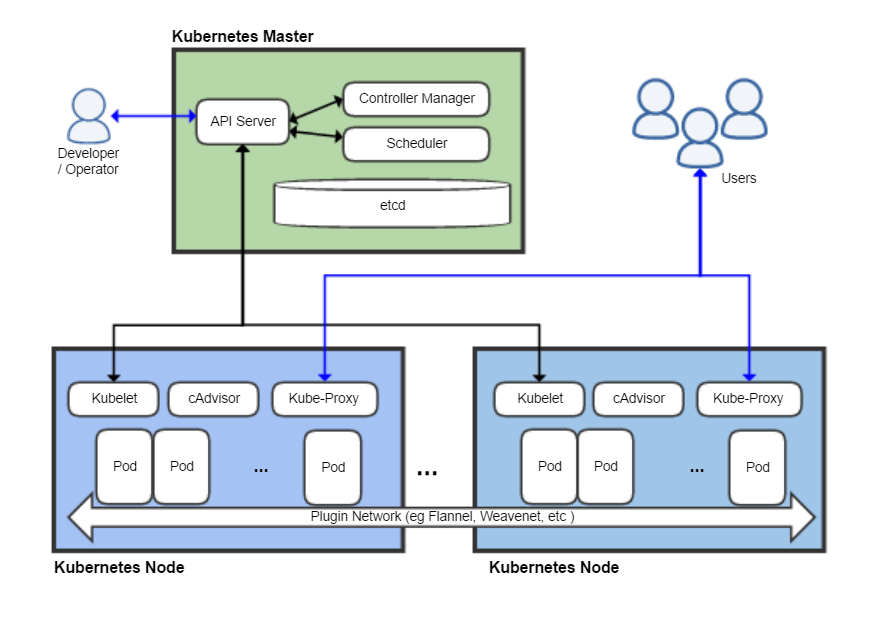 Kubernetes architecture (Image credit)
Kubernetes architecture (Image credit)Within this context, the year 2017 was marked by a collaboration between the Cloud Foundry and Kubernetes communities. As a result, the Open Service Broker API now provides a common standard for services integration, supporting interoperability of services between Cloud Foundry, Kubernetes, and OpenShift.
Also, initiated by Pivotal and Google, the new Cloud Foundry Container Runtime (first appearing as the Kubo project) allows users to launch a Kubernetes environment managed by BOSH. The project aims at becoming a uniform way to deploy and manage highly available Kubernetes clusters on any cloud.
Then, in November, SUSE launched its Cloud Application Platform, integrated with Kubernetes. Its Stratos-UI web interface allows for making use of all the features provided by CF CLI and CF API. This platform is expected to be certified by the Cloud Foundry Foundation this year, according to Abby Kearns.
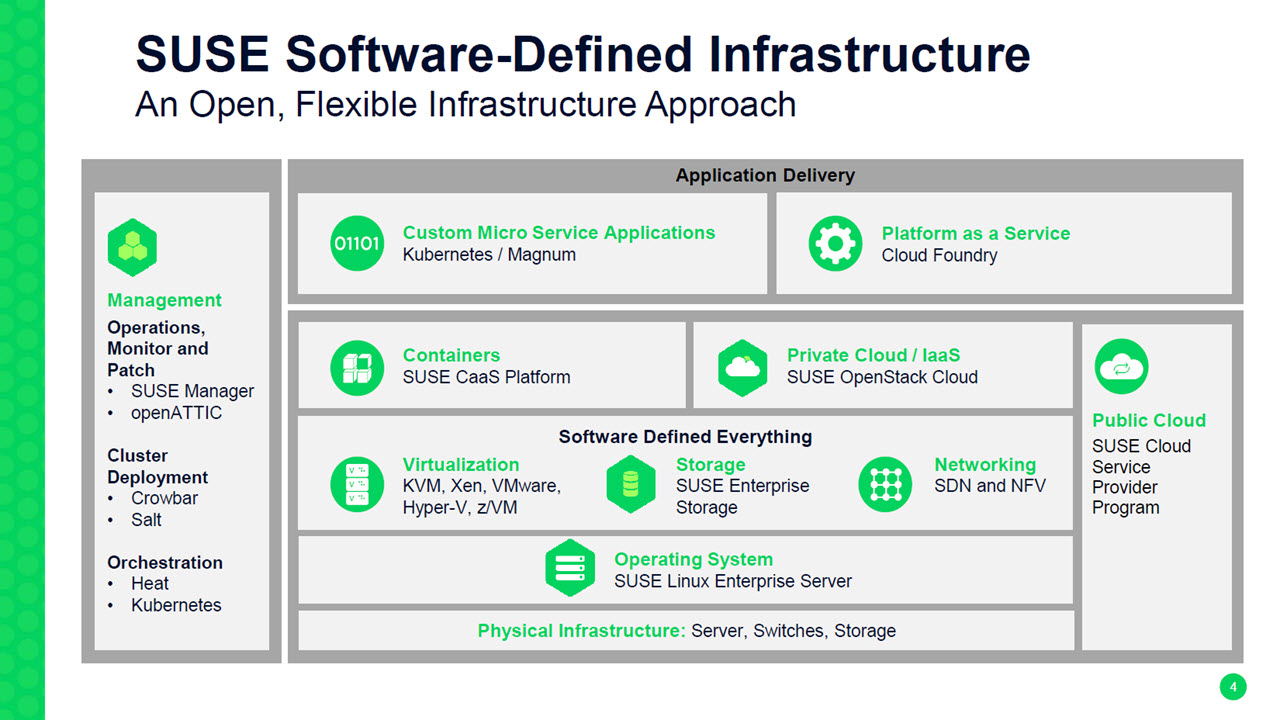 SUSE software-defined infrastructure (Source)
SUSE software-defined infrastructure (Source)Open-source ecosystems represent an important side topic to the cloud-native discussions (around Cloud Foundry/PaaS, Kubernetes, etc.), albeit an important one. The Cloud Foundry ecosystem continued to evolve in 2017, as the surprising rise of Kubernetes from that of an interesting geek project to the clear navigator (so to speak) of all things cloud. Now, it even has its own ecosystem.
This year, open-source ecosystems will no doubt continue to grow, interrelate, and result in vast toolboxes of options for developers. This includes the ongoing debates about the use of microservices and containers (even though Docker debates in particular seem so 2015).
We’re joyful to live in a world replete with such a panoply of options extending to the world of technology. Thus, thinking in terms of varietals, as one would with wine, is the way to approach any single organization’s infrastructure needs. Companies should boldly go into an aggressive cloud-development program with no preconceived notions. This approach will lead to creating the exquisite balanced, flexible, sort-of future-proofed cloud-based infrastructure that’s needed.
Trend #4: Blockchain adoption
Oh, blockchain, blockchain, blockchain, how you torment us all! Pronouncements of blockchain as being everything from a universal solvent to the handmaiden of the devil dominated the year.
It’s commonly said that John D. Rockefeller knew the Great Crash of 1929 was coming when a young shoeshine boy asked him for stock-market tips. I can report with great accuracy that I’ve overheard speculations about cryptocurrencies in every place I’ve been in recent months, from checkout lines in grocery stores to random holiday parties. But then, I’m no John D. Rockefeller, so maybe my angst is unwarranted.
So, it’s time to breathe in, breathe out. Blockchain is not just being used for interesting PoCs and MVPs these days; there were many real-world, substantial developments within the world of blockchain in 2017. Let’s discuss a few examples.
The development of Hyperledger v1.0 was a big story in 2017, and one of our stories outlined the roadmap before and after v1.0.
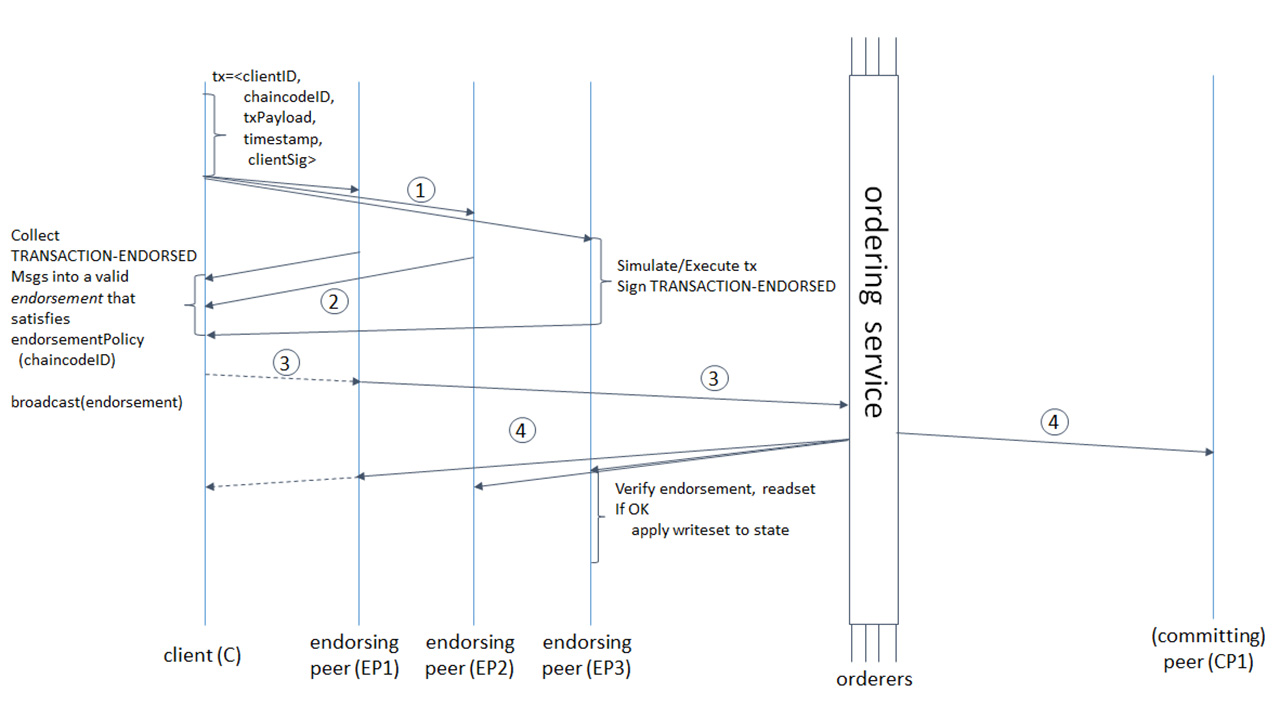 Hyperledger transaction flow (Source)
Hyperledger transaction flow (Source)Blockchain authority Don Tapscott noted eight industries being transformed by the technology. He explained that as transactions costs trend toward zero, fees begin to dominate the thinking of how to make great ideas work. He cited content creators, blockchain cooperatives, supply chains, and essentially anyone handling large amounts of data as potential beneficiaries of blockchain technology.
A need for better provenance emerged as a key objective with many blockchain projects. Boeing, for example, combined an IoT idea with blockchain to track the life cycle and maintenance of parts, working with IBM on the project.
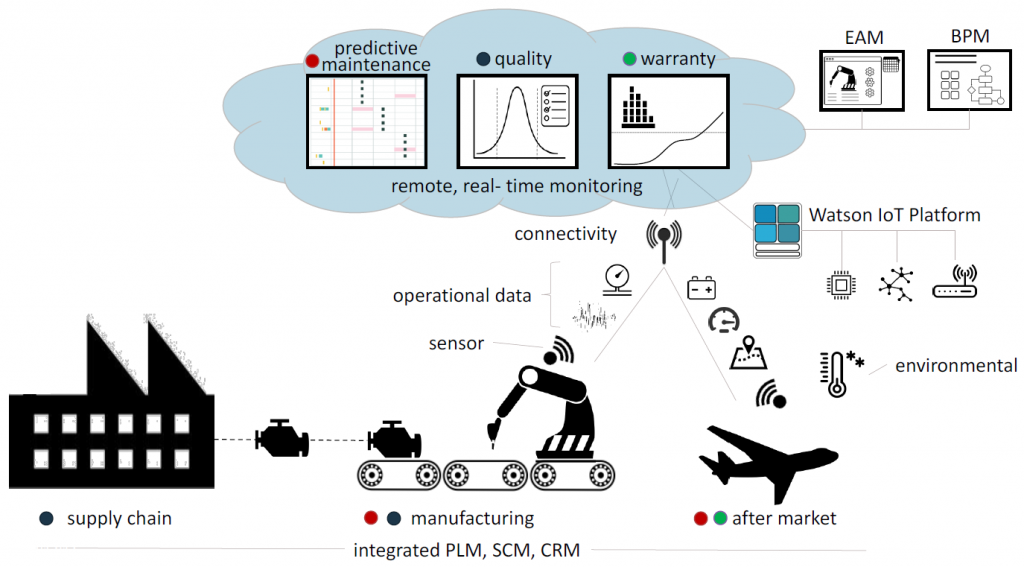 Image credit
Image creditAn end-to-end automotive blockchain emerged as a really cool topic, encompassing things such as tracking the provenance of individual car parts (and the cars themselves), identifying and mitigating counterfeiting, securing vehicles and connected apps, accelerating the autonomous driving initiatives, and implementing dynamic insurance policies. Auto manufacturers including Renault, Porsche, and Toyota are all getting involved in this sort of effort.
Also along the lines of provenance, Everledger makes use of blockchain technology to track and store diamonds. The startup has had significant effects in the diamond industry, going so far as to minimize the occurrence of blood diamonds and other counterfeits. Already tracking 1.2M diamonds on blockchain, Everledger has since expanded its coverage to other luxury goods.
In retail, Walmart is using Hyperledger to inculcate transparency and traceability into the supply chain for its grocery operations. Improvements were effected in the areas of food safety, freshness, waste, fraud, responsible practices, and consumer trust.
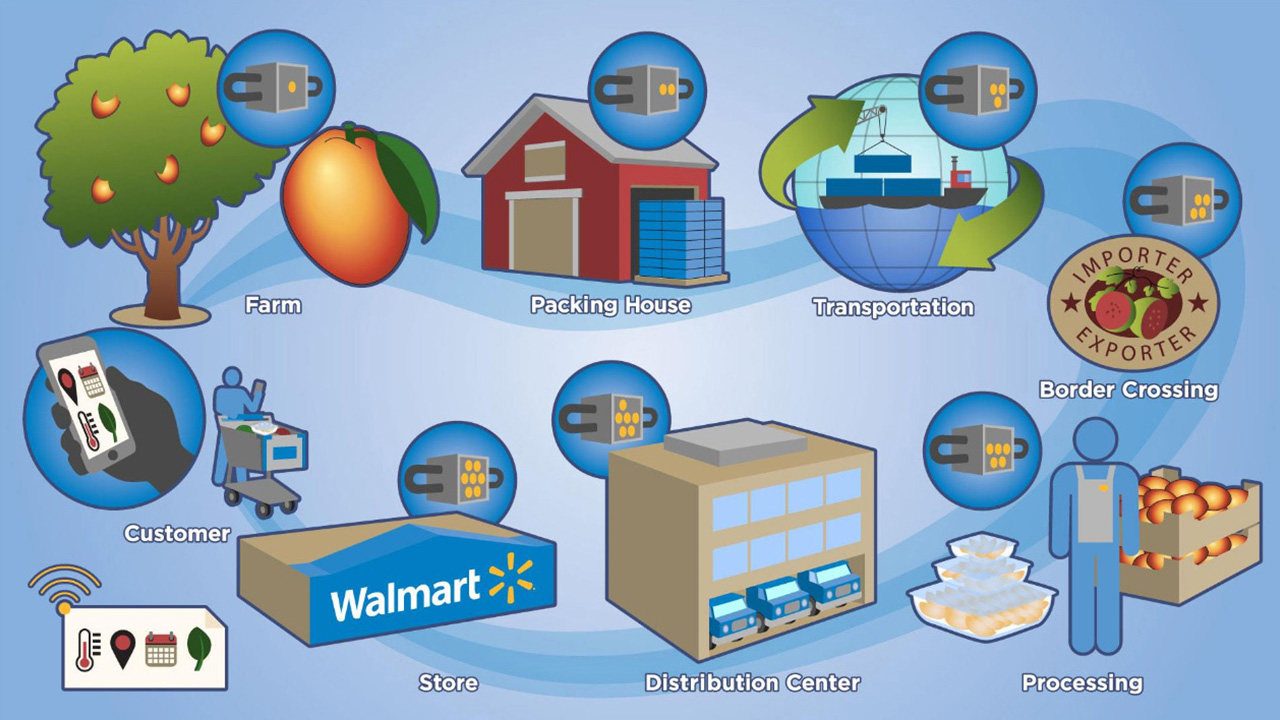 Walmart tracking food “from farm to fork” (Source)
Walmart tracking food “from farm to fork” (Source)The blockchain technology was also used to automate a $10 million bond issuance for Russia’s National Settlement Depository. The project was built on Hyperledger Fabric and delivered in just six weeks.
Many other governments have benefited from the use of the blockchain technology, as well. For example, we reported on how the diverse nations of Australia, Estonia, Georgia, Ukraine, Belarus, Sweden, and the UK are all putting land registries and similar services onto blockchain. Even as they realize the technology is not necessarily a “silver bullet,” blockchain’s transparency and immutability are highly appealing to governmental agencies that are seeking to reduce confusion and fraud and increase the level of services to their citizens.
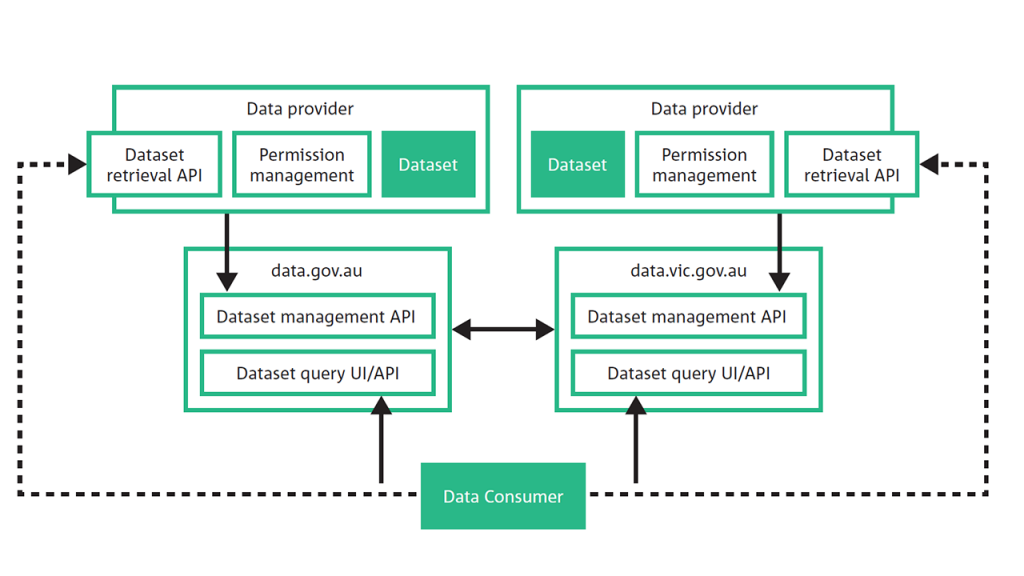 Australia’s open data directories (Image credit)
Australia’s open data directories (Image credit)Insurance providers have also taken an interest in blockchain, seizing on the opportunity to streamline manual processes. This not only cuts down on overall costs, but also speeds up the insurance and reinsurance cycle. Our white paper on blockchain for insurance has more details.
In this spirit, half a dozen Canadian financial institutions have also embraced blockchain, bonding together to seek solutions in areas such as identity management, cross-border transfers, and rewards programs.
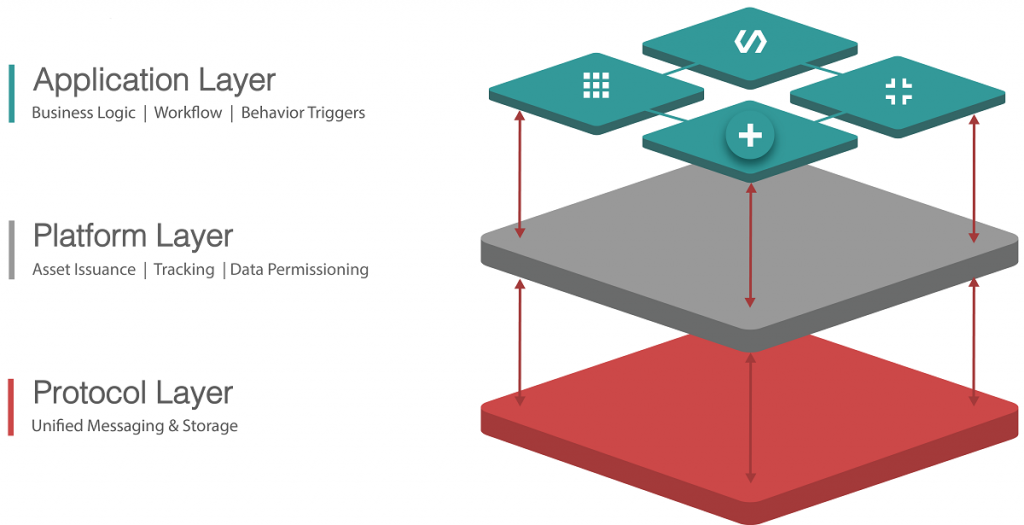 Image credit
Image creditA wrinkle in last year’s proliferation was the addition of Initial Coin Offerings (ICOs) into the mix. These ranged from apparent scams, to specific opportunities for companies to participate in a project’s development. ICOs by another name will continue to be in the news this year. The new terminology for these things is Token Generation Events, an attempt to remove the scam smell by companies that are genuinely interested in having participants, who are not just trying to get in on the latest gold rush.
In 2018, debate will continue as to whether blockchain can truly disrupt many industries with its ability to create immutable records (which government regulators actually love), as well as create separate economies through the chains that include cryptocurrencies.
But the final word on either of these issues won’t occur this year. In fact, it appears to me that we are in the beginning stages of an attempt to re-order the world fundamentally. Think of how empires and their great trading companies fell a hundred years ago to be replaced by nationalist states, which are now being besieged by extra-national communities with cryptocurrencies as their fiat. Thus, either these nascent communities will be crushed by the status quo in the coming years and decades, or they will not. We think it will be a long and fractious struggle.
Trend #3: AI merges with reality
We saw AI (and its subset, machine learning) merging with reality in 2017—not only in the Industry 4.0 world (manufacturing, automotive, etc.), but also on consumer markets, as well as in face-to-face patient care and self-care.
One key area was in the area of connected cars and the vast ecosystems they will require. The invention of the automobile may still go down in history as one of the more unfortunate ideas humans have ever had. (27% of greenhouse gases caused by transportation sector in 2015.) Still, they play the key role in local transportation on a global basis and are now increasingly electric-driven and connected.
Related to the steady progress on connected cars, ambulatory robotics and their ML-driven neural networks seems to be a big issue. Well-known oddball stories involving things, such as out-of-control Teslas and the security robot in Washington, DC, that “committed suicide” made the rounds last year. It’s clear that robots that increasingly look like the cast of machine characters from Star Wars is a big issue.
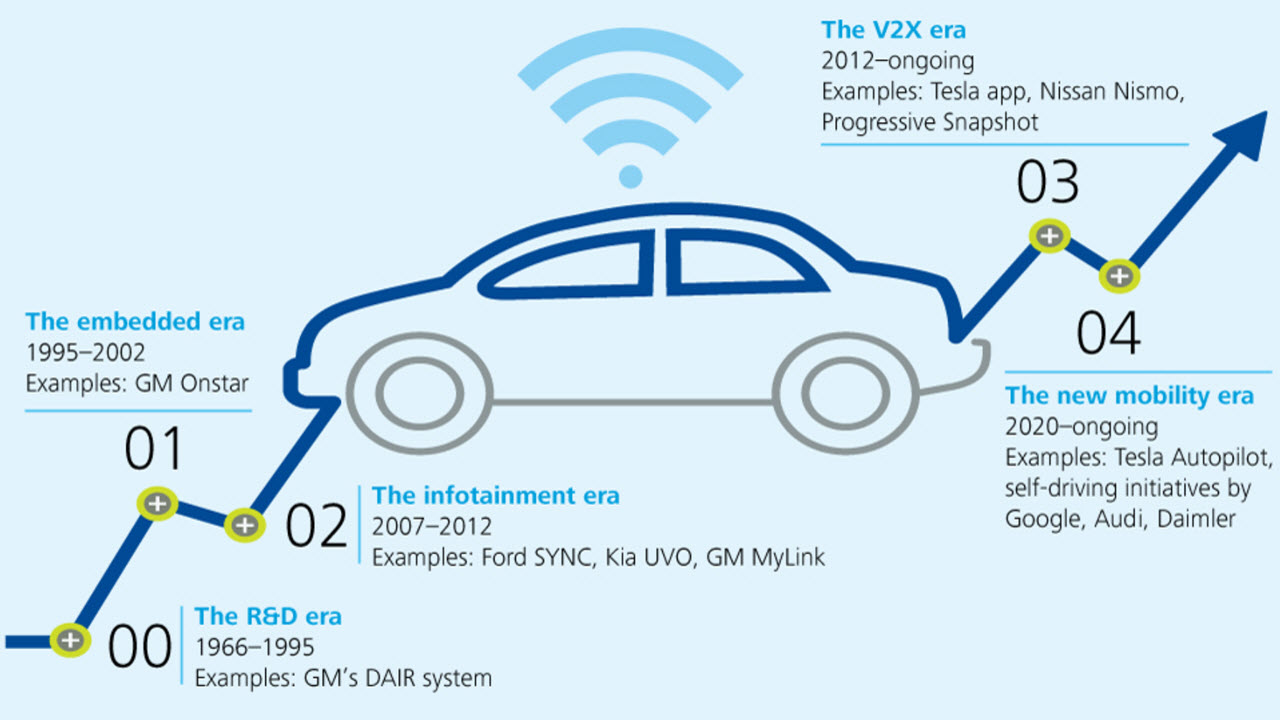 Eras of the Connected Car (Source)
Eras of the Connected Car (Source)A parade of folks at IBM presented how the IoT and AI are spreading across industries, and how Watson is the company’s vehicle to make this happen. Other tools, such as TensorFlow, can be used on neural networks so they can recognize and learn traffic sings. TensorFlow can also be applied in healthcare image recognition, which can help in the detection of diseases.
And so it goes. ML is, in fact, in its infancy. It can make comical mistakes. But in the context of what my best estimate says is a global $12–13 trillion manufacturing industry, every little efficiency improvement has a large economic impact. It’s also worth noting that manufacturing as a percentage of developed economies continues to fall (witness the snappy new graphic from Bruegel below), even as it gets smarter and creates higher level “Q sector” jobs along the way.
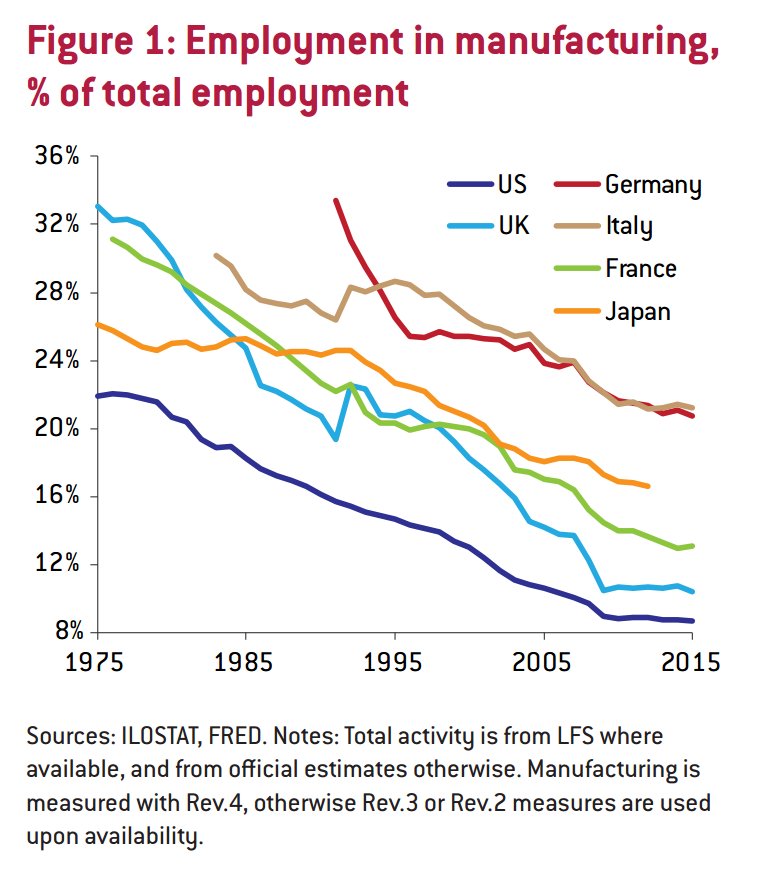 Manufacturing employment in the developed world (Source)
Manufacturing employment in the developed world (Source)
Trend #2: The complexity of systems and infrastructure
Data growth and the creation of a global ZettaStructure may be the most profound trend, one that steadily gurgles underneath our feet rather than evinces itself as a discrete area of development. Data continues to grow at a rate of 24% annually (according to Cisco). This means a doubling every three years, a pace that will launch us into a yottabyte era within 30 years.
Such levels of data growth are no doubt being experienced by most companies, and the data is coming at them in new, diverse, unstructured formats. This presents more of a serious operational challenge to enterprises and data centers, rather than a fecund field of development potential. When I decided to use the term “varietal” rather than “hybrid” last year, I was making the point that each enterprise represents a unique challenge. I’ve taken a look at the Global 2000 enterprises, for example, which have average annual revenues of $11 billion and average annual IT budgets of more than $400 million. But averages don’t reveal the diversity in sizes of these companies.
Witness Walmart at the top with revenues approaching $500 billion, more than twice anyone else on the list. As we move down the list, the number of employees, revenue per employee, price/earnings ratio, and other key measures are, literally, all over the place. It does no good to try to create a credible linear regression or other rational view of all of these companies. Each is its own separate opportunity (looking at things with a glass half-full) or nightmare (looking at a glass half-empty).
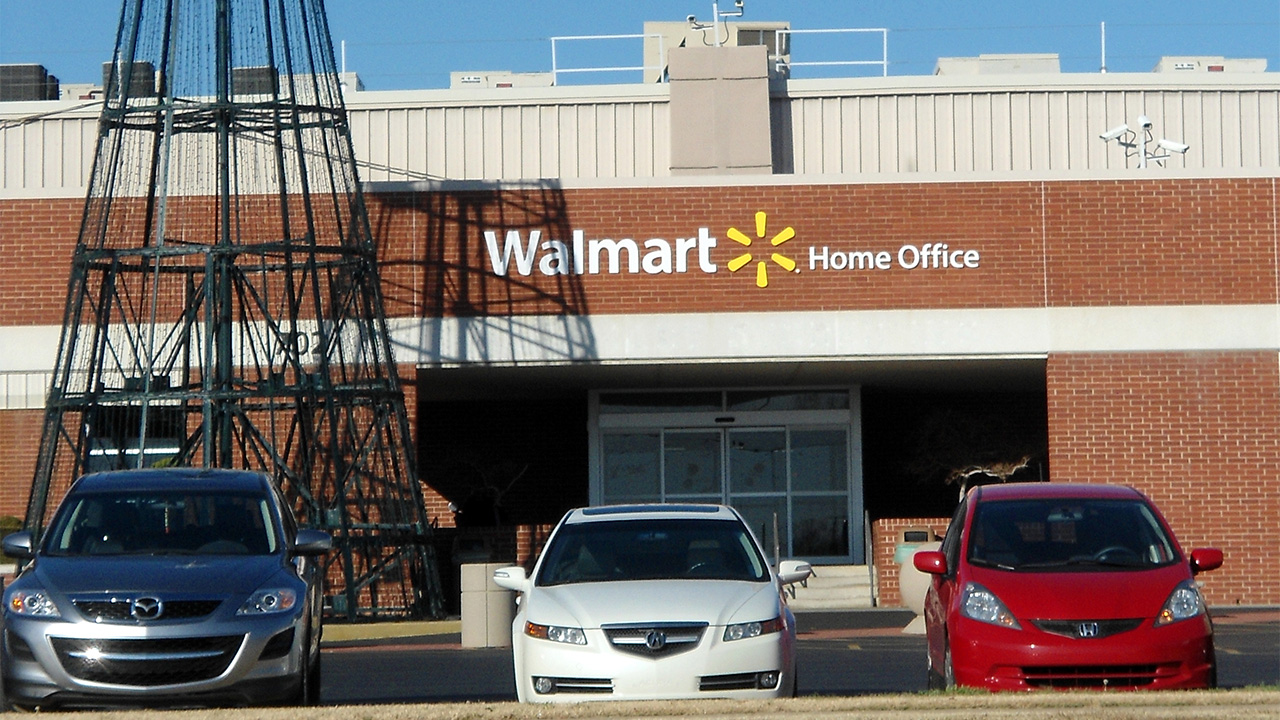 Walmart is the largest F500 company, but as atypical as all members of this big-company club (Source)
Walmart is the largest F500 company, but as atypical as all members of this big-company club (Source)The most serious people I’ve encountered over the past year are what we might call “ZettaStructure people,” those who deal day in and day out with the implications of data that is growing monstrously. Younger folks in the IT industry may take today’s amounts of data for granted, but will soon enough be grappling with a looming yottastructure era. After that, I think we’ll stop being impressed by the amount of data we create, and just assume the data world is a Borges Map of what will then be this quaint concept of the “real” world.
Trend #1: Digital Transformation on a global scale
Significant change—sometimes called a paradigm shift, sometimes a revolution, sometimes a transformation—often comes with the notion that fundamental concepts are no longer valid. A pernicious example of this with cloud computing is the notion that people and process are no longer relevant, the software itself is the solution.
A recent example of this thinking outlines that “most of the processes needed will already be built in (by software vendors today)…these processes may have been optimized, and may be better than your existing ones.” The article goes on to argue that worrying about processes ahead of time only slows down the new implementation.
I would disagree. People, processes, and technology remain the mantra for big-time change. The bottom-line to all of the trends above is our entry into a great new epoch of digital transformation.
The stories we’ve described in this post can all be viewed through the lens of digital transformation. And it’s not only companies that are getting in on the act. We’ve outlined the success of several governments using, in these cases, blockchain technology to become transformative in their efforts to reach their citizens.
Although digital transformation is not a specific product or service you can buy, it has real meaning. Companies that make optimal use of all of their digital assets, and can think of no way to improve how they reach customers, develop products and services, manage supply chains, build revenue, and deliver profitability, have no need to embark down the road of digital transformation. All other companies probably should.
Digital transformation is the really big story, and involves all the issues covered here. We’re looking forward to a wild and crazy 2018, and beyond.
Further reading
- Digital Transformation: What Are the Challenges and Where to Start?
- Initiating Digital Transformation: Nobody Wants to Get “Ubered”
- 2016–2017 Trends: Top 10 Issues of Enterprise IT
- All the World’s a Hybrid Cloud—Or Is It?








